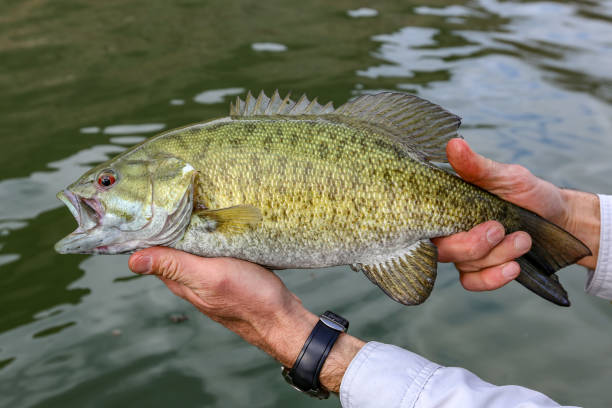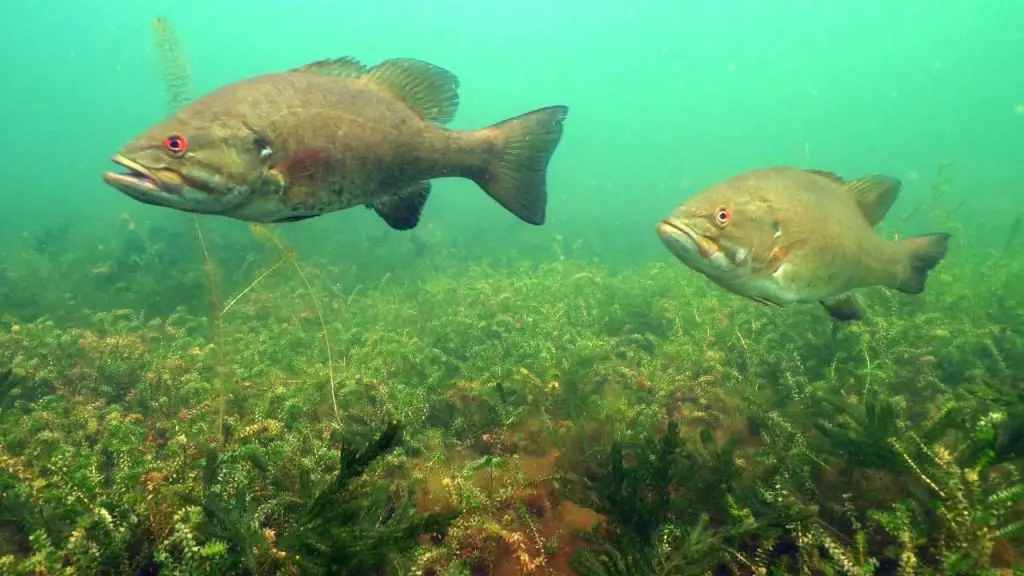Smallmouth bass are one of North America’s most important gamefish. They are famous for their fighting ability when hooked and have the reputation for being, inch-for-inch, the toughest sporting fish around. What Do Smallmouth Bass Eat?
Smallmouth bass are opportunistic predators influenced by H2O temperature that eat whatever live prey is available like:
- Crayfish
- Insects and insect larvae
- Small fish (minnows, shiners)
- Frogs and tadpoles
- Small crustaceans
- Worms and other small invertebrates
- Aquatic plants (rarely)
- Occasionally small mammals
Shiners are a great option for live bait when Smallmouth Bass fishing. These little fish are very lively and will have no problem capturing a Bass’s attention.
Introduction:
Smallmouth bass (Micropterus dolomieu) are freshwater fish native to North America, characterized by their bronze or olive-colored bodies and distinctive dark vertical bands along their sides. These prized sportfish are known for their aggressive strikes and acrobatic fighting style, making them highly sought after by anglers across the continent. Understanding the dietary habits of smallmouth bass is paramount for various reasons.
By unraveling the intricacies of their diet, researchers, anglers, and conservationists can gain valuable insights into the ecological dynamics of freshwater ecosystems. Smallmouth bass plays a crucial role in maintaining the balance of aquatic communities, and their feeding habits directly impact the abundance and distribution of prey species.
Moreover, an in-depth understanding of the smallmouth bass diet is essential for anglers seeking to improve their fishing success. By knowing what smallmouth bass eat, anglers can select appropriate lures, bait, and fishing techniques to target these elusive fish effectively.
Furthermore, the conservation of smallmouth bass populations relies on a comprehensive understanding of their dietary preferences and habitat requirements. By preserving the natural prey base and safeguarding essential habitats, conservation efforts can ensure the long-term sustainability of smallmouth bass populations and the health of freshwater ecosystems as a whole. Thus, delving into the dietary habits of smallmouth bass holds significant implications for both ecological research and resource management practices.

What Do Smallmouth Bass Eat
Smallmouth bass are opportunistic predators that primarily feed on smaller fish such as minnows, shiners, and sunfish. They also consume various aquatic invertebrates including crayfish, insects, and crustaceans. Additionally, smallmouth bass may feed on smaller species of frogs and even small mammals that venture into the water. Their diet can vary depending on prey availability and environmental factors such as water temperature and season. Overall, smallmouth bass are adaptable feeders, capable of consuming a diverse range of prey items within their habitat.
Natural Diet of Smallmouth Bass Fish
A. Overview of Native Habitats
- Smallmouth bass thrive in a variety of freshwater habitats across North America. These habitats typically include clear, cool waters with rocky bottoms, submerged structures like logs and boulders, and ample aquatic vegetation. Smallmouth bass are commonly found in rivers, streams, lakes, and reservoirs, preferring areas with good oxygenation and suitable cover for hunting and shelter.
B. Primary Prey Species
- Invertebrates
- Invertebrates constitute a significant portion of the smallmouth bass diet, especially during their juvenile stages. These include:
- Crayfish: Smallmouth bass are voracious predators of crayfish, which are abundant in rocky habitats. Crayfish provide a high-energy meal rich in protein and essential nutrients.
- Insect Larvae: Smallmouth bass feed on various aquatic insect larvae, including mayflies, caddisflies, and stoneflies, which are prevalent in freshwater environments. These larvae serve as a readily available food source, especially in areas with abundant vegetation.
- Aquatic Insects: Adult insects such as mayflies, dragonflies, and damselflies are also consumed by smallmouth bass when they fall onto the water’s surface, providing opportunistic feeding opportunities.
- Invertebrates constitute a significant portion of the smallmouth bass diet, especially during their juvenile stages. These include:
- Fish
- Smallmouth bass are opportunistic predators and feed on a variety of smaller fish species within their habitats, including:
- Minnows: Small baitfish such as shiners, chubs, and darters are staple prey items for smallmouth bass, particularly in open water areas and along shorelines.
- Sunfish: Juvenile sunfish species like bluegill and pumpkinseed are commonly targeted by smallmouth bass in shallower areas with vegetation cover.
- Perch: Perch species such as yellow perch and white perch are also on the menu for smallmouth bass, especially in areas with rocky structures and deeper waters.
- Smallmouth bass are opportunistic predators and feed on a variety of smaller fish species within their habitats, including:
- Amphibians
- Smallmouth bass opportunistically feeds on amphibians, particularly during warmer months. Amphibians in their diet may include:
- Frogs and Tadpoles: Smallmouth bass prey on frogs and tadpoles found in shoreline areas or shallow waters, especially during breeding seasons when these amphibians are more active.
- Salamanders: Certain salamander species, such as newts and mudpuppies, may also be consumed by smallmouth bass, particularly in habitats with suitable cover and hiding spots.
- Smallmouth bass opportunistically feeds on amphibians, particularly during warmer months. Amphibians in their diet may include:
Understanding the diverse array of prey species consumed by smallmouth bass provides valuable insights into their foraging behavior, ecological role, and interactions within freshwater ecosystems.
Human Influence on Smallmouth Bass Diet
A. Impact of Angling
Angling can significantly influence the diet and behavior of smallmouth bass, leading to both direct and indirect effects on their feeding habits. Key points include:
Selective Pressure: Intensive angling pressure can selectively remove larger individuals from the population, altering the size structure and age distribution of smallmouth bass populations. This selective harvesting can influence the availability and abundance of prey species, as smaller individuals may consume different prey items compared to larger, more dominant fish.
Conditioning: Smallmouth bass can become conditioned to associate certain artificial lures or bait with food, leading to changes in their feeding preferences and behaviors. This can result in increased catch rates for anglers using specific types of lures or bait, as smallmouth bass learn to recognize and respond to these stimuli.
Habitat Disturbance: Angling activities, such as boat traffic and shoreline development, can disturb smallmouth bass habitats and disrupt natural foraging patterns. This disturbance can lead to changes in prey availability and distribution, affecting the diet and feeding behavior of smallmouth bass in affected areas.
B. Introduction of Non-Native Species
The introduction of non-native species can have profound impacts on smallmouth bass populations and their dietary preferences. Key considerations include:
Competitive Interactions: Non-native species introduced to freshwater ecosystems, such as invasive fish species or exotic prey organisms, can compete with smallmouth bass for food resources. This competition can alter the abundance and availability of native prey species, potentially leading to shifts in smallmouth bass diet.
Predation Pressure: Some non-native species introduced for sport fishing or aquaculture purposes may become predators of smallmouth bass or their prey. Predation by non-native species can reduce smallmouth bass populations and disrupt natural food webs, indirectly influencing their diet and feeding behavior.
Altered Ecosystem Dynamics: The presence of non-native species can disrupt the balance of freshwater ecosystems, leading to cascading effects on smallmouth bass and other native species. Changes in habitat structure, water quality, and food availability resulting from the introduction of non-native species can impact the overall health and stability of smallmouth bass populations.
C. Habitat Modification
Human-induced habitat modification can alter the availability of prey species and influence the feeding behavior of smallmouth bass. Key factors include:
Habitat Loss: Urbanization, agricultural development, and infrastructure projects can lead to the loss or degradation of smallmouth bass habitats, reducing the abundance of prey species and limiting foraging opportunities.
Pollution: Pollution from runoff, industrial discharge, and other sources can degrade water quality and negatively impact the abundance and diversity of aquatic organisms, including smallmouth bass prey species. Contaminants can bioaccumulate in the food chain, affecting the health and condition of smallmouth bass and influencing their diet.
Habitat Enhancement: Restoration and conservation efforts to improve smallmouth bass habitats can enhance prey availability and support healthy populations. Habitat enhancement projects, such as stream restoration, riparian buffer establishment, and aquatic vegetation management, can provide essential habitat features for smallmouth bass and their prey, contributing to more diverse and resilient ecosystems.
Understanding the various ways in which human activities influence the diet of smallmouth bass is essential for effective fisheries management and conservation efforts aimed at preserving healthy populations and sustainable ecosystems.
Conservation Implications
A. Importance of Preserving Natural Prey Base
Preserving the natural prey base is crucial for maintaining the health and sustainability of smallmouth bass populations and freshwater ecosystems. Key considerations include:
Ecological Balance: Smallmouth bass are vital in controlling prey populations and maintaining ecological balance within freshwater ecosystems. By consuming a diverse array of prey species, smallmouth bass help regulate population sizes and prevent the overabundance of certain prey species, which can negatively impact water quality and habitat conditions.
Food Web Dynamics: The availability of natural prey species supports complex food webs and trophic interactions within freshwater ecosystems. Protecting and preserving the diversity of prey species ensures the stability and resilience of these food webs, supporting the overall health and productivity of aquatic communities.
Species Interactions: Smallmouth bass rely on a variety of native prey species for nutrition and energy. Alterations to the natural prey base, such as declines in crayfish populations or shifts in fish communities due to non-native species introductions, can have cascading effects on smallmouth bass populations and their interactions with other species within the ecosystem.
B. Sustainable Fishing Practices
Adopting sustainable fishing practices is essential for ensuring the long-term viability of smallmouth bass fisheries and minimizing negative impacts on populations and ecosystems. Key principles of sustainable fishing practices include:
Catch-and-Release: Encouraging catch-and-release practices helps maintain healthy population sizes and genetic diversity among smallmouth bass populations. Releasing fish unharmed allows them to contribute to future spawning events and maintain natural reproductive dynamics.
Regulated Harvest: Implementing and enforcing regulations on harvest limits, size restrictions, and fishing seasons helps prevent overexploitation of smallmouth bass populations and ensures sustainable harvest opportunities for anglers.
Selective Harvest: Practicing selective harvest by targeting smaller or more abundant individuals for harvest while releasing larger, reproductive adults helps maintain population structure and genetic diversity within smallmouth bass populations.
C. Habitat Restoration Efforts
Habitat restoration efforts play a critical role in enhancing the quality and availability of habitat for smallmouth bass and their prey species. Key components of habitat restoration efforts include:
Riparian Zone Protection: Protecting riparian zones and streamside vegetation helps maintain water quality, stabilize streambanks, and provide essential habitat for smallmouth bass and their prey. Riparian buffer establishment can reduce erosion, filter pollutants, and provide shade and cover for aquatic organisms.
Stream and River Restoration: Restoring natural stream channel morphology, including riffle-pool sequences, instream habitat features, and woody debris recruitment, improves habitat diversity and complexity for smallmouth bass and other aquatic species.
Wetland Conservation: Protecting and restoring wetland habitats provides critical spawning, nursery, and foraging areas for smallmouth bass and their prey species. Wetlands act as nutrient sinks, sediment traps, and biological hotspots, supporting diverse and productive ecosystems.
By prioritizing the preservation of the natural prey base, adopting sustainable fishing practices, and investing in habitat restoration efforts, conservationists can contribute to the long-term conservation and management of smallmouth bass populations and their freshwater habitats. These conservation actions help maintain the ecological integrity of freshwater ecosystems and ensure the continued enjoyment of smallmouth bass fisheries for future generations.




